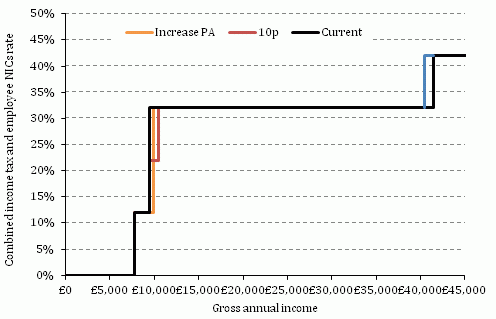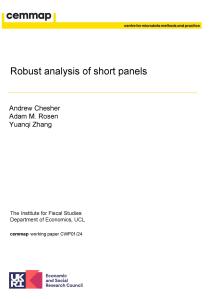In a speech in Bedford today, the Leader of the Opposition, Ed Miliband, has proposed reintroducing a 10% income tax rate on a narrow band of income, to be paid for by a new ‘mansion tax’ on residential properties worth more than £2 million. This observation discusses the merits of both of these policies and suggests more economically sensible policies that would have broadly the same effects.
‘Mansion tax’
Mr Miliband did not give precise details of the design of his ‘mansion tax’ in his speech, but a similar proposal from the Liberal Democrats in their 2010 General Election Manifesto would have involved a tax based on 1% of a property’s value above £2 million. Thus, a property worth £3 million would face a charge of £10,000 a year. No firm costings are available for such a tax, but in 2010 the Liberal Democrats estimated that 70,000 properties would be affected and the total yield from this tax would be £1.7 billion a year, implying that the average charge would be over £24,000 per year. Of course, a higher or lower charge could raise more or less revenue.
The ‘mansion tax’ has a sensible logic underpinning it: if residential property is to be taxed, it makes sense to levy such a tax in proportion to property value and base it on current valuations. By contrast, Council Tax, the existing tax on residential property in England and Scotland, has neither of these features as it is based on 1991 property values and is set far from proportional to those values, with higher-value properties significantly under-taxed: for example, in a local authority setting the current English average band D rate, someone with a property at the midpoint of band D will pay 1.85% of its 1991 valuation in Council Tax whereas someone with a property at the midpoint of band G will pay 1.00% of its 1991 valuation. Therefore, rather than adding a mansion tax on top of an unreformed and deficient council tax, it would be better to reform council tax itself to make it proportional to current property values. As with the mansion tax, it would be the most valuable properties that saw the largest increases in tax liability from such a reform.
10p tax rate
A 10p tax rate previously existed between 1999 and 2007 before it was (in)famously abolished for non-savings income by Gordon Brown in his last Budget as Chancellor, and still exists for savings income that falls into the first £2,710 of taxable income. Reintroducing Labour’s 10p rate in full would reduce tax revenues by around £7 billion a year and benefit basic rate taxpayers by up to £271 a year, though given the numbers above, it is unlikely that anything close to this amount could be raised through a mansion tax alone. To introduce a £1,000 10p tax band, which would benefit all 23.5 million basic-rate taxpayers, one would need to raise £2 billion, or around £30,000 on average from each of the 70,000 owners of ‘mansions’. (Higher-rate taxpayers would not benefit from the Labour party’s proposals as they would reduce the point at which the higher 40p income tax rate starts to be applied. The proposal would therefore slightly increase the number of higher rate taxpayers, which is something the current Government has done to limit the gains to higher rate taxpayers from its increases in the income tax personal allowance.)
A 10p tax rate would reduce taxes for those on low incomes and strengthen their work incentives. A far simpler and more sensible way of achieving these aims would be to spend the same amount of money on increasing the personal allowance – a policy on which the current government has already spent £9 billion a year. This would have virtually the same impact on individuals’ tax payments (see figure below), be slightly more progressive, take some people out of income tax altogether and avoid the complexity involved in introducing a new income tax rate. An even better alternative, which would help those who already pay no income tax because their incomes are below the personal allowance but do pay employee National Insurance Contributions (from April, there will be 1 million such people earning between £7,748 and £9,440), would be to increase the point at which individuals start paying employee National Insurance Contributions. This would also bring the income tax and National Insurance systems more in line and would take some people out of direct tax altogether. And if one wanted to focus the gains from the policy on low-income working families rather than basic-rate taxpayers generally, increasing Working Tax Credits would be another sensible alternative to look at.
Figure: Effect of a £1 billion giveaway through either a 10p tax rate or an increase in the personal allowance on combined income tax and employee NICs schedule

Note: Reforms considered are £1,000 10p tax band and £500 increase in the personal allowance. In both cases, there is an offsetting reduction in the higher-rate threshold so that higher-rate taxpayers are unaffected.
Summary
Both the proposals made today by the Labour party will be familiar to tax policy watchers. One, the mansion tax, reflects a problem with the current tax system – council tax is regressive as high-value properties are under-taxed relative to low-value properties – but does not take the idea forward to its logical conclusion. The other, the proposal for a new 10p starting rate of income tax, has no plausible economic justification. It would complicate the income tax system and achieve nothing that could not be better achieved in other ways. It appears to repeat the same error perpetrated by Denis Healey in 1978 (undone by Geoffrey Howe in 1980), Norman Lamont in 1992 and Gordon Brown in 1999 (which he himself undid at considerable political cost in 2007). To have observed lower starting rates of tax being introduced and abolished by governments of both complexions over the last three decades and then to propose the same thing again suggests a remarkable failure to learn from history.










